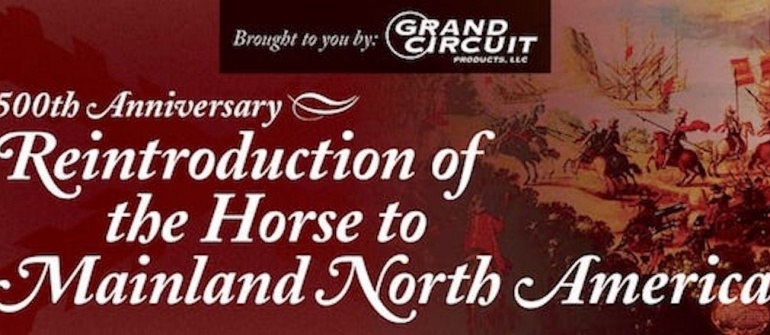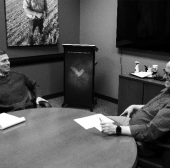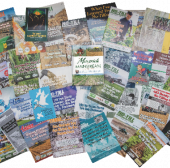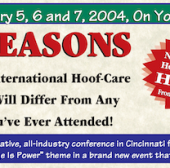By Jeremy McGovern, Executive Editor/Publisher of American Farriers Journal
From the September 2019 Lessiter Link Newsletter
April 22, 2019 marked the 500th anniversary of the horse's permanent reintroduction to the North American mainland. Landing in Veracruz, Hernan Cortes launched the conquest of the Aztec empire, in which the horse played a crucial role.
Colonial powers primarily relied on the horse as a war machine and cargo transport. Once the conquistadors defeated the Aztecs and adopted Spanish agrarian and ranching practices, the horse flourished. Through other expeditions by Spain, France and England, the horse population grew throughout North and South America.
What Happened to the Horse in North America?
Theories on early equine populations in North America are based on archaeological records. Among the genus Equus, several species were present in North America dating back millions of years ago. Though scholars differ, it is estimated that the genus Equus was eradicated from our continent 8,000 to 10,000 years ago. One of the main causes of this extinction were the cultures that migrated through the continent, crossing at Beringia (the land bridge where the present-day Bering Straits is located). Horses were food to these settlers, and over-hunting helped decimate the population. Climate and dietary changed also contributed to the horse's demise.
As North and South America waited for the horse's return, the role of the animal changed in Eurasia, as domestication occurred about 3,500 B.C. The horse became less of a food source and became a mode of transportation (riding and driving) and an agrarian tool. Despite becoming a beast of burden, horses have never disappeared from the human diet. For example, in France, Japan and Mexico, the horse is considered a delicacy. Today, many unwanted horses in the U.S. are exported for slaughter and become human food in Asia and Europe.
The Horse's Return
The first reintroduction of the horse came with Columbus in 1493 on his second voyage. His first voyage intended to find a new route to the Orient and Asia. Upon his return to Spain, there was tremendous investment in his subsequent expeditions, with the expectation of settlement.
In early 1519, Cortes launched from Cuba, eventually arriving on Veracruz on April 22. With Cortes was Bernal Diaz, who documented the conquest in his writings. A skilled horseman, Diaz gives details on the horses used throughout this conquest. He even delivers some minor details on the blacksmiths, who were essential not only for the hoof care of the horses, but also for making tools, weapons and restraints.
The horse amazed the Aztecs. Early, they thought the horse and rider to be a single animal. They would use carefully choreographed military demonstrations with the horse to intimidate King Moctezuma and his people. All of this appears in Diaz's accounts, including how the Spaniards hid a mare in heat behind a curtain to excite a stallion visible to the Aztec audience. The stallions' reaction and behavior terrified and impressed the Aztecs.
In his final assault on the capital of Tenochtitlan (modern Mexico City), Diaz used 86 horses. The Aztec Empire fell in 1521 and the Spaniards continued the colonial development throughout Mexico over the coming decades.
The Horse's Migration
"Reintroduction" of the horse means a permanent establishment and breeding of the animal. Other explorers had used the horse on mainland North America prior to Cortes, such as various campaigns in Panama. The extreme heat and humidity of equatorial portions of North and South America proved inhospitable long-term for horses before settlement and husbandry changes. However, the horse thrived in central Mexico. Spanish ranching quickly took hold and the Spanish settlements spread north through Mexico and into the U.S.
These ranching practices likely caused the myth of the wild horse in the Southwest. The mustangs and other "wild" horses in the region are not wild, but rather feral. One of the main sources of the bloodlines of these horses were horses that wandered away from ranches, which were free range and unfenced. There is no such thing as wild horses — all horses today are descended from domesticated stock.
Through Spanish expansion, El Paso and Santa Fe became the early horse centers of the U.S. The Spanish also brought the horse to the first settlement in Florida at St. Augustine. English settlers brought their stock to their Northeast and Mid-Atlantic settlements. The French first brought horses to Canada at the permanent settlement of Montreal.
The key ecological zone that allowed the horse populations to explode over a few centuries was from central Mexico, across the Rio Grande, through the Great Plains and into Canada. This was the same zone in which the horse's ancestors grazed, reproduced and thrived millennia ago. As North America equine biologist Dr. Deb Bennett told me, "And the grass looks up at the horse and says, 'Yes, I remember you.'"
Creating the Product
American Farriers Journal commemorated this event with a 4-page insert in our April 2019 issue. Writing and publishing a piece on a general equine subject isn't typical for us, but neither are 500th anniversaries. Rare opportunities present new ways to engage our audience and find additional revenue. Concerning our business, there are several key takeaways on finding publishing success.
Align with the Leading Experts. Dr. Jorge Murga, and equine veterinarian who practices in California and Mexico, alerted us to this milestone. He also is a historian who has studied the horse's role in colonial Mexico.
Through contacting several academics who are experts on the history of Spanish colonialization and Aztec history. I found they were aware of the horse's impact in North and South American history, but the permanent reintroduction did not register as a milestone. Murga has been the leader in the equine industry in promoting this anniversary. First altering me at an equine veterinarian conference, Murga also helped in subsequent phone calls and emails. He shared Diaz's 16th century account with me, which became an important source for understanding the horse's role in the Aztec conquest. We are more successful when listening rather than talking. By networking and investing the time with an industry member, a new idea emerged.
I found a book on the equine migration through North America by Bennett. She helped me boil down the complex subject of equine migration to something that could be digested by our audience.
Be Creative, but be Efficient. Editors should think about the full potential of content while planning and collecting information. Sometimes that potential is recognized early, sometimes not until much later. Yes, ideas come forward upon reflection, but for maximum efficiency, we should collaborate. By examining the full potential of content during the planning stage, we can develop ideas beyond a single product and not resolve to simply replicating the content product as a digital or print product.
Bennett was an important source for this article. Instantly, I recognized her authority, as well as her colorful nature. Because there is always potential to use audio from an interview in a podcast or video, I typically record my interviews over Skype for better quality. Her command of the subject and relatability to farriers over audio made the interviews a great fit for the podcast. The only additional work was making the interview more conversational for listening, as sometimes the way we interview for written compositions can be dry or formulaic when presented as a podcast.
By reading Diaz's account and Bennett's work, a 3-part podcast series was produced from a 2-hour recorded phone call. This was transcribed and used largely for creating the article.
Don't Give Up — Regroup and Reassess. The original scope of this project was an 8- or 16-page report to polybag, along with a podcast series. There certainly was enough material to easily fill that page count editorially. However, the ad sales outlook never justified the additional printing and production costs. So, the scoped was scaled back to a 3- to 4-page article in the magazine. Although we were still commemorating this anniversary with a good story, this was a disappointing outcome.
Credit goes to Amy Johnson for salvaging the editorial and ad sales potential of this idea. After I announced we would eliminated the polybagged report, she investigated the costs to do a shorter report as an insert in the issue. She presented this as an alternative and once approved, sold the print idea to a sponsor. This required no extra work from editorial or design, as Lew Horn had already mocked a design theme for the original scope. Because the podcast series was not part of her proposal to the client, we were able to sell it for additional income.





